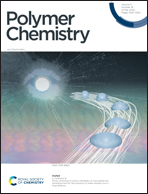Injectable dual cross-linked adhesive hyaluronic acid multifunctional hydrogel scaffolds for potential applications in cartilage repair†
Abstract
Injectable hydrogels have shown great potential for cartilage tissue engineering as three-dimensional cell culture scaffolds, owing to their similarity to the extracellular matrix (ECM), which endows them with the ability to match irregular defects, minimally invasive properties and convenience for cell transplantation and proliferation. However, injectable hyaluronic acid (HA) hydrogels have limited applications in cartilage tissue engineering due to their poor mechanical properties and fast enzymatic degradation. In this study, a double cross-linked (DC) hydrogel was designed and prepared by combining the Diels–Alder click reaction and a phenyl boronate ester bond, in which the DA reaction provides mechanical properties and the phenyl boronate bond provides versatility, such as injectability, adhesion and anti-degradation. Compared with the single cross-linked hydrogel, the DC hydrogel not only possessed good injectability and pH responsiveness, but also had repeatable strength and durability. In addition, in vitro cell experiments indicated that the injectable DC hydrogel was capable of supporting cell loading and proliferation, thus being a promising candidate for repairing cartilage defects.



 Please wait while we load your content...
Please wait while we load your content...